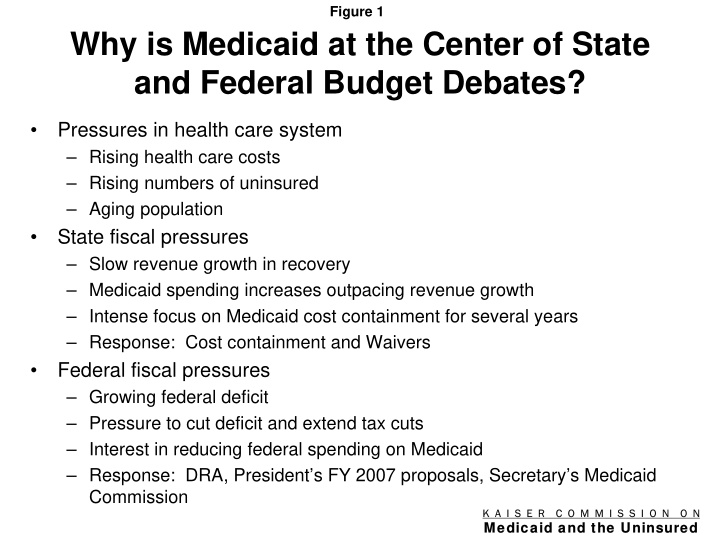



Figure 1 Why is Medicaid at the Center of State and Federal Budget Debates? • Pressures in health care system – Rising health care costs – Rising numbers of uninsured – Aging population • State fiscal pressures – Slow revenue growth in recovery – Medicaid spending increases outpacing revenue growth – Intense focus on Medicaid cost containment for several years – Response: Cost containment and Waivers • Federal fiscal pressures – Growing federal deficit – Pressure to cut deficit and extend tax cuts – Interest in reducing federal spending on Medicaid – Response: DRA, President’s FY 2007 proposals, Secretary’s Medicaid Commission K A I S E K A I S E R C R C O M M I S S I O M M I S S I O O N N O N O N Medicaid and the Uninsured Medicaid and the Uninsured
Figure 2 Distribution of Medicaid Spending Reductions in the Deficit Reduction Act 2006-2010 2006-2015 Other Prescription Drug Payment Long-Term Care Benefits and Cost Sharing 37% 28% 5 Year Savings = $11.5 Billion 10 Year Savings = $43.2 Billion Note: “Other” provisions in the conference report include targeted case management, third-party recovery, provider taxes, and requiring evidence of citizenship K A I K A I S E S E R C R C O M M I S S I O M M I S S I O O N N O N O N SOURCE: CBO, January 27, 2006 Medicaid and the Uninsured Medicaid and the Uninsured
Figure 3 Cost Sharing and Benefit Provisions in the DRA • Cost sharing and premiums – Allows states to impose higher or new cost sharing and premiums – Allows states to make cost sharing “enforceable” – Maintains exemption for mandatory children and pregnant women (except for non-preferred prescription drugs) • Benefit “benchmarks” – Allows states to use “benchmark” plans for certain groups (family planning, mental health & rehabilitation services may not be covered) – Maintains current benefits for individuals with disabilities or long term care needs (guidance suggests that mandatory adults can be subject to limits) – Maintains EPSDT coverage as wrap-around for children • Allows variation in benefits and cost sharing across groups and geographic areas K A I S E K A I S E R C R C O M M I S S I O M M I S S I O O N N O N O N Medicaid and the Uninsured Medicaid and the Uninsured
Figure 4 DRA Requires Proof of Citizenship for Medicaid • DRA requires all new and current Medicaid enrollees to provide documentation to prove citizenship • Main sources of documentation include U.S. passport or birth certificate – HHS given authority to list alternative documents (not released yet) • Effective date: July 1, 2006 • Will impose new administrative burdens for states and new barriers for beneficiaries to obtain and retain Medicaid • Many states have been working to simplify eligibility process • Wide range of estimates about coverage impact K A I S E K A I S E R C R C O M M I S S I O M M I S S I O O N N O N O N Medicaid and the Uninsured Medicaid and the Uninsured
Figure 5 Medicaid Spending Reductions in the DRA Attributable to Asset Transfer Changes 2006-2010 2006-2015 Other Treatment of Annuities -$2.4 Billion Treatment of Home Equity Changes to the Penalty Period -$6.4 Billion K A I K A I S E S E R C R C O M M I S S I O M M I S S I O O N N O N O N SOURCE: CBO, January 27, 2006 Medicaid and the Uninsured Medicaid and the Uninsured
Figure 6 Key Medicaid LTC Spending Increases in the Deficit Reduction Act $11.4 Billion Long-Term Care Partnership Program Cash and Counseling Programs Money-Follows-the- Person Home and Community $2.6 Billion Based Services Family Opportunity Act 2006-2010 2006-2015 K A I K A I S E S E R C R C O M M I S S I O M M I S S I O O N N O N O N SOURCE: CBO, January 27, 2006 Medicaid and the Uninsured Medicaid and the Uninsured
Figure 7 Emerging Trends in Medicaid • Emphasis on personal behavior and responsibility – “Consumer choice” of plans / Long-term Care Services – Increased premiums and/or cost sharing – Behavior modification through incentives • “Tailored” benefits – Variation in benefit packages across groups or geographic areas • Increased role of private marketplace – Increased control to plans to determine benefit packages – Emphasis on premium assistance – Public/private long-term care partnerships • Restricting spending/increasing spending predictability – Defined contribution approaches – Aggregate cap on federal funding K A I S E K A I S E R C R C O M M I S S I O M M I S S I O O N N O N O N Medicaid and the Uninsured Medicaid and the Uninsured
Figure 8 Issues to Consider for Women’s Medicaid Coverage • What do the DRA and recent waiver changes mean for availability and affordability of women on Medicaid? • How is fiscal responsibility and risk shifting among the federal government, states, plans, and beneficiaries? • Will variations in coverage for women between and within states broaden? • What is the right balance between state flexibility and federal standards? • Are changes occurring with enough evaluation, transparency, and accountability? K A I S E K A I S E R C R C O M M I S S I O M M I S S I O O N N O N O N Medicaid and the Uninsured Medicaid and the Uninsured
Recommend
More recommend